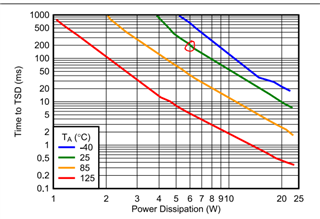Hi. In my application, one actuator is moving a mechanism and this mechanism can find obstacles if there is a malfunction. I want to use this eFuse as an overcurrent protection, when the actuator hits this possible obstacle, the current will increase and it's when I want the eFuse to act, shutting down and sending a FLT signal to the MCU. That's why I want to use the specific part TPS259461LRPWR (latch and FLT pin). This actuator is moving a variable load so the current changes along the range of the linear actuator. The maximum current measured along this range is 1.6 A so I want to set the current limit to 2 A (due to tolerances).
I'd need help to confirm and figure out the following parameters:
1) According to my measurements, when there is an obstacle and the current reaches 2.7 A (I'm choosing 2.7 A because it'd be a good point for the eFuse to act) , the voltage in the actuator is 12.1V, that gives me a resistance of 12.1/2.7 = 4.5 ohm. So the output voltage in the eFuse would be 2A * 4.5 ohm = 9V. That it's giving me a power dissipation of (12.1 V - 9V) * 2 A = 6.2 W. And according to the plot of the datasheet, it'd take around 200 ms for the eFuse to enter in the thermal shutdown (25 degrees):

Please confirm me if this makes sense, taking into account my specific application.
2) If I don't need to use the SPLYGD pin, can I leave it floating?
3) In order to calculate the CdVdT value, the datasheet provides the following equations:
"SR = Vin/tr" How can I know the ideal "tr" for my application?
With that, I already can calculate the CdVdT value (CdVdT = 2000/SR) but in order to calculate the Inrush current, I need to know the Cout value (Iinrush = SR * Cout), how can I estimate the value of Cout? I don't only need to know this value for the Inrush current calculation but for the schematic too.
4) As I've said, I want to use the FLT feature, so in order to do that, I need to pull up this pin to a digital voltage value (5V in my case) through the resistor Rflt. The problem is that my product works with a battery and I want to save as much current as possible. Can the value of this resistor be high so that the current in the FLT circuit is of the order of uA?
Thank you very much in advance.

